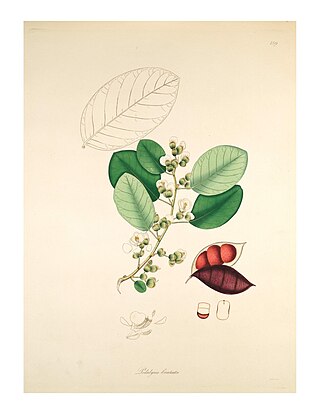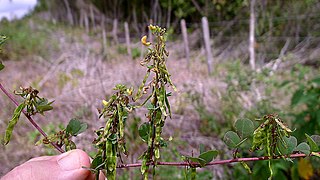
Camoensia is a genus of 2 species of lianas in the family Fabaceae, subfamily Faboideae, native to the Gulf of Guinea, Africa. C. scandens is cultivated as an ornamental plant; it has one of the largest leguminous flowers, up to 20 cm across. The genus has classically been assigned to the tribe Sophoreae, but was recently assigned to its own monophyletic tribe, Camoensieae, on the basis of molecular phylogenetic evidence. Species of Camoensia are known to produce quinolizidine alkaloids, consistent with their placement in the genistoid clade.
Ormocarpopsis is a genus of flowering plants in the family Fabaceae. It includes eight species of shrubs or small trees endemic to Madagascar. They inhabit seasonally-dry tropical forest, woodland, and xerophytic shrubland, sometimes on rocky outcrops of sandstone or limestone. They are found throughout the island except in the eastern lowland rain forest. The genus was recently assigned to the informal monophyletic Dalbergia clade of the Dalbergieae. It contains the following species:
Ormocarpum is a genus of flowering plants in the legume family, Fabaceae. It includes 17 species native to tropical and southern Africa and parts of India, Indochina, Malesia, Papuasia, and the South Pacific. The genus was recently assigned to the informal monophyletic Dalbergia clade of the Dalbergieae.

Paramachaerium is a genus of flowering plants in the family Fabaceae native to Amazonia. It was recently assigned to the informal monophyletic Pterocarpus clade within the Dalbergieae.

Amphimas is a small genus of flowering plants in the family Fabaceae. It belongs to the subfamily Faboideae. It is a west African tree used for medicine and for wood. Amphimas was traditionally assigned to the tribe Sophoreae; however, recent molecular phylogenetic analyses reassigned Amphimas into an unspecified position in the Meso-Papilionoideae.
Baphiopsis parviflora is an African species of flowering plants in the legume family, Fabaceae. It is the sole species in genus Baphiopsis. It is a shrub or tree which ranges from Cameroon to Tanzania and Angola.

Cranocarpus is a genus of flowering plants in the legume family, Fabaceae. It includes three species native to northern and eastern Brazil. It belongs to subfamily Faboideae, and was recently assigned to the informal monophyletic Pterocarpus clade of the Dalbergieae.

Dalhousiea is a genus of flowering plants in the legume family, Fabaceae. It belongs to the subfamily Faboideae. It includes two species, one native to central Africa, and the other to eastern India, Bangladesh, and Myanmar.
Fiebrigiella gracilis is a species of flowering plants in the legume family, Fabaceae. It is the only member of the genus Fiebrigiella. It belongs to the subfamily Faboideae, and was recently assigned to the informal monophyletic Pterocarpus clade of the Dalbergieae. It is a subshrub native to Ecuador, Peru, and Bolivia.
Fissicalyx fendleri is a species of flowering plant in the legume family, Fabaceae. It is a tree native to the tropical Americas, ranging from Panama through Colombia, Venezuela, and Guyana to northern Brazil. It grows in humid lowland forest.

Hymenolobium is a genus of flowering plants in the family Fabaceae. It includes 14 species of trees native to Central America and northern South America, ranging from Honduras to Bolivia and southeastern Brazil. Most species are native to Brazil, the Guianas, and Venezuela, with one extending into Peru, another into Ecuador, and one native to Central America. Trees are typically very tall and emergent in tropical humid lowland rain forest.

Luetzelburgia is a genus of flowering plants in the legume family, Fabaceae. It includes 14 species of trees and shrubs native to Brazil, Bolivia, and Colombia. Typical habitat is seasonally-dry tropical lowland woodland and wooded grassland, and occasionally lowland rain forests. The genus belongs to the subfamily Faboideae. It was traditionally assigned to the tribe Sophoreae, mainly on the basis of flower morphology; recent molecular phylogenetic analyses assigned Luetzelburgia into an informal, monophyletic clade called the "vataireoids". Keys for the different species of Luetzelburgia have been published.

Poiretia is a genus of flowering plants in the family Fabaceae. It includes 12 species of twining, scandent, or erect herbs and shrubs native to the tropical Americas, ranging from southern Mexico to northern Argentina, including Cuba and Hispaniola. Most species are native to eastern Brazil, Paraguay, and northern Argentina; Poiretia punctata ranges further north and west to northern South America, Central America, Mexico, and the Caribbean. Typical habitats include seasonally-dry tropical to subtropical riverine forest, woodland (cerrado), grassland, and shrubland.
Ramorinoa girolae is a species of flowering plant in the legume family, Fabaceae. It is the sole species in genus Ramorinoa. It is a xerophytic tree or shrub native to La Rioja, San Juan, and San Luis Provinces of western Argentina. Unlike most legumes, Ramorinoa girolae does not produce any leaves. It grows in subtropical lowland and lower montane dry forest or shrubland in rocky and sandy areas. It is locally known as chica, and stands of R. girolae are known as chicales. It belongs to the subfamily Faboideae, and was recently assigned to the informal monophyletic Pterocarpus clade within the Dalbergieae. It is the only member of the genus Ramorinoa.
Riedeliella is a genus of flowering plants in the legume family, Fabaceae. It includes three species of scandent shrubs native to Paraguay and eastern and west-central Brazil. They grow in seasonally-dry tropical forest, cerrado, and caatinga. The genus belongs to the subfamily Faboideae, and was recently assigned to the informal monophyletic Pterocarpus clade within the Dalbergieae.
Soemmeringia semperflorens is a species of flowering plants in the legume family, Fabaceae. It is the only member of the genus Soemmeringia.
Sweetia fruticosa is a species of flowering plants in the legume family, Fabaceae. It is a tree native to eastern, southern, and west-central Brazil, Bolivia, Paraguay, and northeastern Argentina. It is the only member of the genus Sweetia. It belongs to the subfamily Faboideae. It was traditionally assigned to the tribe Sophoreae, mainly on the basis of flower morphology; recent molecular phylogenetic analyses assigned Sweetia fruticosa into an informal, monophyletic clade called the "vataireoids".

Vatairea is a genus of flowering plants in the legume family, Fabaceae. It includes eight species of tall trees native to the tropical Americas, ranging from southern Mexico to Bolivia and southern Brazil. Seven species are native to northern South America, with the center of diversity in Amazonia. Vatairea lundellii ranges from southern Mexico to Panama. Most species grow in tropical rain forest, often in the inundated forests known as igapó and varzea, where they are emergent trees, growing above the forest canopy. V. macrocarpa grows in seasonally-dry forest, cerrado, and caatinga.

The vataireoids are an early-branching monophyletic clade of the flowering plant subfamily Faboideae that are mostly found in northern South America, primarily Brazil.
Bowringia is a genus of flowering plants in the legume family (Fabaceae), found in tropical Africa and southeastern Asia. It includes four species native to western and central Africa and Madagascar, and to Borneo, Indochina, and southern China.








